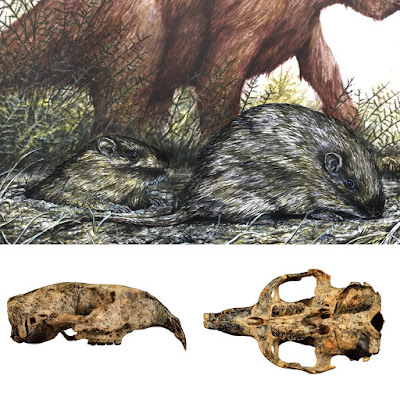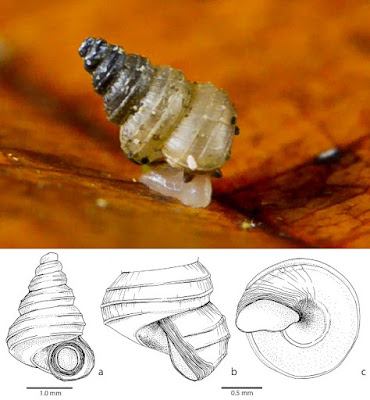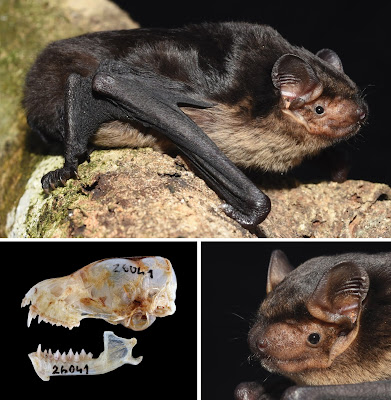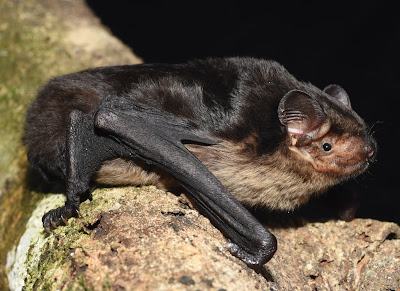[Most Recent Entries] [Calendar View]
Friday, February 21st, 2020
| Time | Event | ||||||||||||
| 3:01p | [PaleoMammalogy • 2019] Proclinodontomys dondasi • A New Echimyid Genus (Rodentia, Caviomorpha) in Central Argentina: Uncovered Diversity of A Brazilian Group of Mammals in the Pleistocene
Abstract We describe a new extinct spiny rat, Proclinodontomys dondasi n. gen. n. sp. (Rodentia, Caviomorpha, Echimyidae), represented by a noteworthy preserved skull and mandible from the early-middle Pleistocene outcrops at the coastal cliffs of SE Buenos Aires Province (Central Argentina). Phylogenetic analyses allow us to propose that the new species described here and the already known Eurzygomatomys mordax (Winge) represent a new genus closely related to the living Euryzygomatomys spinosus and Clyomys laticeps. The new genus differs from Euryzygomatomys and Clyomys by having much more procumbent upper incisors, a more developed fossa for the M. temporalis, more flared and laterally expanded zygomatic arches, frontal less markedly expanded posteriorly, jugals much deeper anteriorly than posteriorly, with the dorsal border descending more abruptly posteriorly, smaller orbital cavity, and external auditory meatus relatively smaller and slanted upward and backward. Several features of the new species reflect a higher degree of adaptation to semifossorial habits than those of E. spinosus. The origin of the semifossorial ecomorphotype within echimyids may have been triggered by the expansion of relatively open and arid environments that arose near the Miocene-Pliocene boundary. The record of this new echimyid in Central Argentina indicates that during the early-middle Pleistocene, the southern limit of the geographic range of extinct representatives of the Brazilian lineage of semifossorial echimyids extended farther south than that of their living members. Family Echimyidae Gray, 1825 Subfamily Eumysopinae Rusconi, 1935 Genus Proclinodontomys new genus Type species.—Proclinodontomys dondasi n. gen. n. sp. Other species.—Proclinodontomys mordax n. comb. (Winge, 1887). Etymology.—From Greek pro = anterior, clino = inclination, odonto = tooth, mys = mouse; in reference to the fact that is a rodent with the front teeth inclined forward. Proclinodontomys dondasi new species Etymology.—The species name honors Alejandro Dondas (1948–2016), colleague and friend, tireless finder of fossils at the Atlantic cliffs of Buenos Aires Province and for many years head of the Paleontology Department of the Museo Municipal de Ciencias Naturales de Mar del Plata “Lorenzo Scaglia.” The specific epithet is formed from the surname “Dondas,” taken as a noun in the genitive case, plus the Latin suffix “i” (ICZN, 1999; Article 31.1.2). Proclinodontomys mordax (Winge, 1887) new combination 1887 Mesomys mordax Winge, p. 72, pl. 8, fig. 7. 1946 Euryzygomatomys mordax (Winge); Paula-Couto, p. 5. Adriana M. Candela, Marcos Cenizo, Daniel Tassara, Luciano L. Rasia, Céline Robinet, Nahuel A. Muñoz, Carola Cañón Valenzuela and Ulyses F. J. Pardiñas. 2019. A New Echimyid Genus (Rodentia, Caviomorpha) in Central Argentina: Uncovered Diversity of A Brazilian Group of Mammals in the Pleistocene. Journal of Paleontology. 94(1); 165–179. DOI: 10.1017/jpa.2019.73 Hallaron una rata espinosa fósil de más de 400 mil años de antigüedad CTyS.com.ar/index.php?idPage=20&idArticu | ||||||||||||
| 3:02p | [Mollusca • 2020] Craspedotropis gretathunbergae • A New Species of Cyclophoridae (Gastropoda: Caenogastropoda), discovered and described on A Field Course to Kuala Belalong Rainforest, Brunei
Abstract Background: Terrestrial Caenogastropoda form an important but threatened component of the Borneo tropical rainforest malacofauna, where the group is nearly as rich in species as the Stylommatophora. They are, however, more sensitive to drought, temperature extremes and forest degradation. New information: On a field course at Kuala Belalong Field Studies Centre in Brunei Darussalam (Borneo), a new caenogastropod species, belonging to the genus Craspedotropis, was discovered by the course participants. The participants decided to name the species Craspedotropis gretathunbergae n. sp., in honour of the climate change activist Greta Thunberg, as caenogastropod land snails, such as this species, are likely to suffer because of climate change. Keywords: Land snails, Borneo, lowland dipterocarp rainforest, new species
Craspedotropis gretathunbergae, sp. n. Nomenclature: Craspedotropis Blanford 1864 sensu Vermeulen (1999). Type species: Craspedotropis cuspidata (Benson 1851) Diagnosis: Amongst the Bornean cyclophorids, Craspedotropis gretathunbergae n. sp. is most similar to C. borneensis (Godwin Austen 1889), which, however, is somewhat less slender, has 7 - 9 spiral ribs and more broadly reflected apertural lip. In addition, the operculum of C. borneensis has raised whorl margins, which is not the case in C. gretathunbergae n. sp. Other Asian species, with which the new species may be confused, are: (i) Cyathopoma conoideum Sykes 1898, which has a more slender shell and the spiral ribs arranged in a different pattern, with the second rib located just above the suture; (ii) C. sivagherrianum Beddome 1875, which is smaller, has 7 spiral ribs and a nearly closed umbilicus; (iii) C. beddomeanum Nevill 1881, which has more (7 - 8) and more prominent, spiral ribs, more globular whorls and a rounder aperture; (iv) C. procerum Blanford 1868, which is stockier, has 9 - 12 spiral ribs and a peristome that is strongly thickened by folds. Etymology: We name this species in honour of the young climate activist Greta Thunberg, because caenogastropod microsnails from tropical rainforests, like this new species, are very sensitive to the droughts and temperature extremes that are likely to be more frequent as climate change continues. Via mutual contacts, we have approached Ms. Thunberg and learned that she would be 'delighted' to have this species named after her. Following Recommendation 51C of the Code (ICZN 1999), if it is desired that authorship of the name be included as part of the name, instead of listing all authors, the species can be referred to as Craspedotropis gretathunbergae Schilthuizen et al., 2019, provided that all authors of the name are cited in full elsewhere in the same work, either in the text or in a bibliographic reference. Distribution: Borneo: Brunei Darussalam: Temburong District: Ulu Temburong lowland rainforest. Ecology: In tropical mixed dipterocarp lowland rainforest. All individuals were found alive at the foot of a steep hill-slope, next to a river bank, foraging at night on the upper surfaces of green leaves of understorey plants, up to 1 m above ground level. Taxon discussion: The generic classification of minute cyclophorids in Southeast Asia is somewhat confused. The genera Craspedotropis Blanford 1864, Cyathopoma Blanford 1861 Blanford and Blanford 1861, Jerdonia Blanford 1861 (Blanford and Blanford 1861; sometimes considered a subgenus of Cyathopoma) and Ditropopsis Smith 1897 appear poorly defined and may be partly overlapping or synonymous (Vermeulen et al. 2015, Vermeulen 1999). In its general shell form (a tall conical shell with spiral ribs), the present species is similar to several species of Cyathopoma (e.g. the South Asian C. conoideum Sykes 1898, C. sivagherrianum Beddome 1875, C. beddomeanum Nevill 1881 and C. procerum Blanford 1868) and Craspedotropis, especially C. borneensis (Godwin Austen 1889), known from Sarawak. Given the geographical proximity of the latter, we have tentatively placed the new species in the same genus, Craspedotropis. Discussion: All work described in this paper (fieldwork, morphological study, microphotography, taxonomic description and diagnosis) was carried out in a field centre with basic equipment and no internet access, by untrained ‘citizen scientists’ guided by expert scientists, on a 10-day taxon expedition. While we are aware that this way of working has its limitations in terms of the quality of the output (for example, we were unable to perform dissections or to do extensive literature searches), the benefits include rapid species discovery and on-site processing of materials. Menno Schilthuizen, Jonathan P. Lim, Anthonie D. P. van Peursen, Massimiliano Alfano, Awang Bikas Jenging, Daniele Cicuzza, Alexandre Escoubas, Pierre Escoubas, Ulmar Grafe, Jamil Ja, Peter Koomen, Aleks Krotoski, Denise Lavezzari, Laura Lim, Rudie Maarschall, Ferry Slik, Derek Steele, Dennis Teck Wah Ting, Ine van Zeeland and Iva Njunjić. 2020. Craspedotropis gretathunbergae, A New Species of Cyclophoridae (Gastropoda: Caenogastropoda), discovered and described on A Field Course to Kuala Belalong Rainforest, Brunei. Biodiversity Data Journal. 8: e47484. DOI: 10.3897/BDJ.8.e47484 | ||||||||||||
| 3:09p | [Mammalogy • 2020] Mirostrellus joffrei • A New Genus of Vespertilionid Bat: The End of A Long Journey for Joffre’s Pipistrelle (Chiroptera: Vespertilionidae)
Abstract Knowledge as to the taxonomic status of enigmatic bat species often is hindered by limited availability of specimens. This is particularly true for aerial-hawking bats that are difficult to catch. One such species, “Hypsugo” joffrei, was originally described in Nyctalus due to its long and slender wings, but subsequently transferred to Pipistrellus, and most recently to Hypsugo, on the basis of morphology. Analysis of newly available material, which more than doubles the known specimens of this taxon, demonstrates that it is morphologically and genetically distinct from all other bat genera. We accordingly describe it as belonging to a new, monotypic genus. We provide a detailed description of its external and craniodental traits, measurements, and assessment of genetic relationships, including barcode sequences to facilitate its rapid identification in future. The new genus belongs to a group that includes the recently described Cassistrellus, as well as Tylonycteris, and its closest relative, Philetor. We also describe the echolocation calls emitted by members of the taxon in different situations, which may facilitate finding them in previously unsampled locations. Based on the new data, the species occurs from Nepal to North Vietnam and China, which suggests that it could be more widespread than previously thought. Keywords: Indomalayan region, mtDNA, nuDNA, phylogeny, systematics, Vespertilionini
Mirostrellus gen. nov. Type species: Nyctalus joffrei Thomas, 1915. Etymology: From the Latin “mirus” meaning “surprise, marvel,” which reflects that both the systematic position and the wide distribution of this bat (previously thought to be extremely rare) were pleasant surprises for the authors. Diagnosis: A medium-sized vespertilionid, with a FA of 35.7–40.2 mm. The fifth finger of the wing is shortened (on average 20 mm shorter than the fourth finger) and the pelage is sparse and velvety. The supraorbital tubercles are well-developed, protruding for 1.47–1.76 mm measured from the lachrymal opening; the sagittal crest is barely visible, being only approximately 0.1 mm high. The upper canine is characterized by a developed posterior secondary cusp. The taxon has two upper and lower premolars and its lower molars are myotodont.
Geographic distribution: The only known species of Mirostrellus gen. n. has an Indomalayan distribution, ranging from Nepal, NE India (Sikkim, Meghalaya), through the northern part of Myanmar, to North Vietnam (Saikia et al. 2017). In the National Museum of Prague (Czech Republic), four hitherto unreported specimens from western Yunnan, China (Zao Teng He, ..., 1,451 m a.s.l.), were revealed by SVK. The species probably also occurs between these localities as it is difficult to capture and so may be missed during faunal surveys (Fig. 10). Tamás Görföl, Sergei V. Kruskop, Vuong Tan Tu, Péter Estók, Nguyen Truong Son and Gábor Csorba. 2020. A New Genus of Vespertilionid Bat: The End of A Long Journey for Joffre’s Pipistrelle (Chiroptera: Vespertilionidae). Journal of Mammalogy. gyz202. DOI: 10.1093/jmammal/gyz202 |
| << Previous Day |
2020/02/21 [Calendar] |
Next Day >> |


















